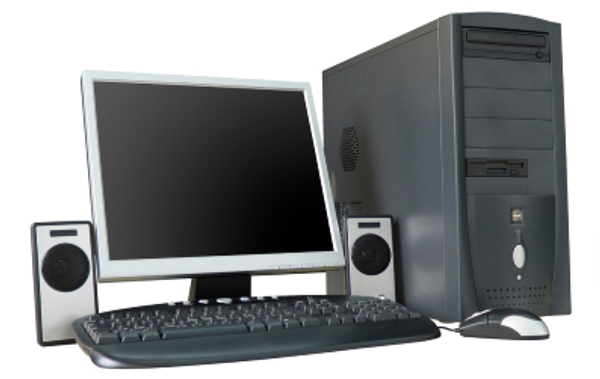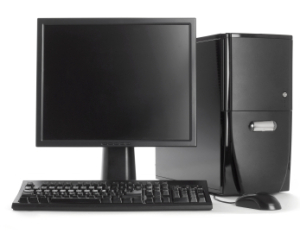Types of computer
What are the different types of computers?
Different types of computer systems are nowadays available for different purposes according the user needs.
When you’ll have to order yours or even to build it, you should first define the expected use of your computer.
This step will help you to describe the basic capabilities and know the costs of your system.
What are the different types of computer system?
This is a brief view of the main expressions used to describe your computer.
Personal computers or microcomputers
Microcomputers are built to be used by one person. In fact when you talk about personal computers or its common acronym PC, you always mean microcomputers. For surfing the web, playing games or music, editing and many other tasks… you ordinarily use personal computers either at school, at home or at business.
You’ll find personal computers in two (2) major types: desktop and laptop.
If you opt for a desktop computer you have to set it up in a permanent location. Fortunately you are able to choose your preferred sizes such as a mini, mid or full tower.
You should then add many other devices to complete it such as keyboard, mouse and monitor which can be a CRT or LCD display.
What about Workstations and Servers?
If you need a high-end micro computer you should go for a workstation. This type of computer is recommended if you are working in game development, scientific calculations, engineering or 3D graphics. It is fastest than the common personal computer and even it can be used as server if you need to build a basic network client by example.
The server is generally used for a major client with the purpose to allow many users working together over a network. Servers require powerful processors, large amount of hard disk drives and ram memory.
Types of mobile computers
If you prefer the laptop you’ll go for the mobile or portable system. Your notebook, a common name of laptop, has the advantage to have all the parts built together.
Your notebook has the same computing power to the desktop machine but it is enough lightweight to be portable. If the mobile machine is relatively more expensive it’s because it costs more to design the small components.
Maybe you’ll need greater portability. So a handheld micro computer is your first option. To manage your phone book, diary or taking notes...etc a Personal Digital Assistant (PDA) is useful.
You can also use the Palmtop, a tinier laptop than the PDA, to the same purposes and even more. The Palmtop is designed with a small keyboard and a flip-up screen and is more usable to surf the web while you are on the move.
Types of mini computers
Apart the micro computers, you may consider three other types of computers: the minicomputers, the mainframes and the supercomputers.
Be advised that the name minicomputers does not mean it is slowest than your PC. Surely not! If you plan to build a home network the minicomputers can be used as a mid- range server to serve multiple users.
However with the mainframe you are able to build a large network for several hundred clients. You can process millions of transactions daily with the mainframe because of its high capacity. Most of enterprises such as large organizations, insurance businesses, industry, banking … usually use the mainframe for processing and storing enormous amounts of data every day.
The supercomputer is the fastest machine in the history of computer not only for its size but especially for its capacity. You won’t have to use this powerful system unless you are working with nuclear or aerodynamic companies for example.
Conclusion Through this brief description you had opportunity to learn a lot about the different generation of computer. Nowadays many electronics devices are working like computers. Your iPod, your cell phone or even your watch has an integrated computer application. In the near future you can’t imagine what you are expected as newer types of computer!
Conclusion Through this brief description you had opportunity to learn a lot about the different generation of computer. Nowadays many electronics devices are working like computers. Your iPod, your cell phone or even your watch has an integrated computer application. In the near future you can’t imagine what you are expected as newer types of computer!
-----------------------------------------------------------------------------------------------
Understanding Your Computer
Understanding the anatomy of a PC is no easy task, even if you've used one every day for years. You may have heard the terms "motherboard" or "central processing unit," but asking most people to define these very essential components is likely to draw blank stares.

The two main types of computers are portable and desktop. Portable computers come in various shapes and sizes, and include laptops and hand-held devices. Desktops are stationary, typically with a more powerful configuration. Several components are essential to both. Hands down, the most powerful component of a computer is the central processing unit (CPU). Other basic and necessary components include memory, the motherboard, the hard drive and the power supply.

Central processing unit
The CPU handles all of the computation work and is distinguished by its speed. The higher the speed, the faster the PC. If you're watching high-definition movies or manipulating graphics, then you'll need a computer with fast processing.Random access memory (RAM)
Your computer can't function without memory. RAM is the hardware inside the computer that stores information. Get a minimum of 512 megabytes -- memory is even more important than the speed of the processor. The more RAM a computer has, the more smoothly the PC will run when using several programs at once. While adding more memory later isn't time consuming, getting what you need when you purchase the computer is worthwhile and may be more cost effective.Motherboard
The motherboard provides the connections within the computer and hosts the RAM, microprocessor and drive controllers. The microprocessor is the brain of the computer and controls the operations, while the drive controllers enable the computer's hard drive to work. The motherboard should have at least two USB ports to plug in a digital audio player or additional memory drive.Hard drive
All data created on the computer, whether it's homework, business files or personal data, are stored on the hard drive. It has a much larger capacity than the RAM.Power supply
The last of the mandatory computer components is the power supply. While it may be the simplest, it's absolutely essential for allowing the computer to work. Enough said.
Modem
With the Internet being the center of the world for many of us, access to it could actually move to the essential list. Most PCs have a modem for dial-up Internet access and an Ethernet port for broadband access. For a wireless connection, you'll need a wireless network adapter, also standard on most computers.CD/DVD drive
A CD or DVD drive (also known as an optical drive) is the readable and/or writable drive that allows users to read from and write to a CD or DVD. Most PCs have an optical drive that can read CDs and DVDs, and for not much more money, you can get a drive that writes, too.Audio/visual extras
Determine whether additional items such as sound cards, graphic cards, video cards or speakers fit your needs. If you want to run games or multimedia programs faster, then many of these options can prove beneficial. Integrated sound is already adequate on most computers, but upgrading to surround sound is a desirable option.
Keyboard, mouse and monitor
The keyboard allows users to enter commands, and the mouse is an interface with the same function. The monitor, serving as a desktop computer screen, comes in various sizes. A small monitor is typically around 17 inches, while greater than 20 inches is considered large. The higher the resolution on the monitor, the better the graphics card you'll need to run games or video-intense applications. If you're undecided, you can't go wrong with a 22-inch digital monitor.Operating system and software
After you've made all the hardware decisions, determine what pre-installed software you'll need for your computer. Select the latest version of an operating system such as Microsoft Windows, the best-selling operating system for years. Also purchase an anti-virus program such as Norton or Trend Micro, and choose from other programs such as word processing and spreadsheets.So much for thinking you couldn't understand a PC from A to Z! This ultra-complex machine deserves our thanks. After all, functioning without a computer these days would be like living in the dark.
niceeeeeeeeeeeeeeeeeeeeeeeeeeeeeeeeeeeeeeeeeee
ReplyDelete